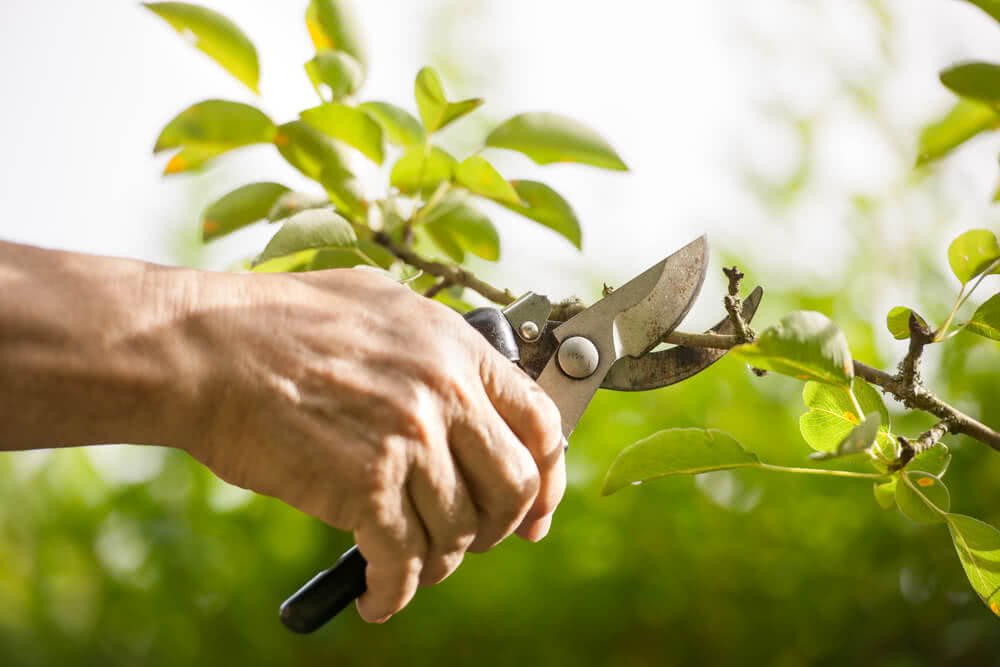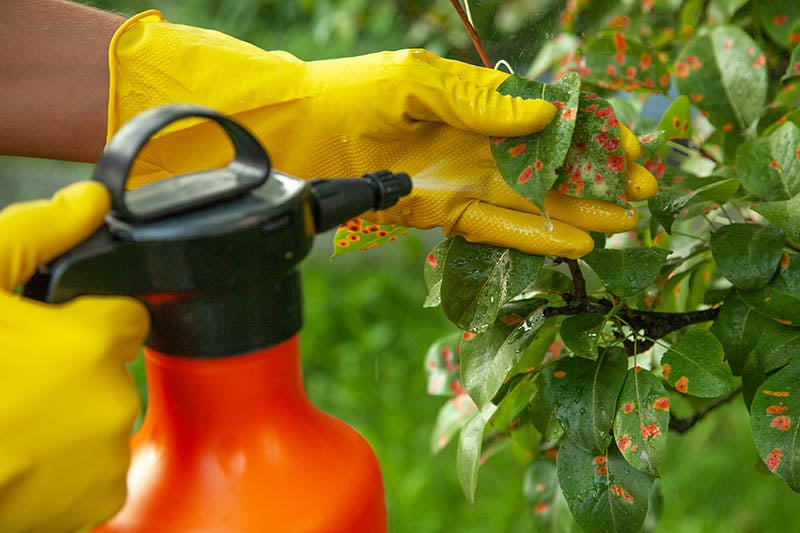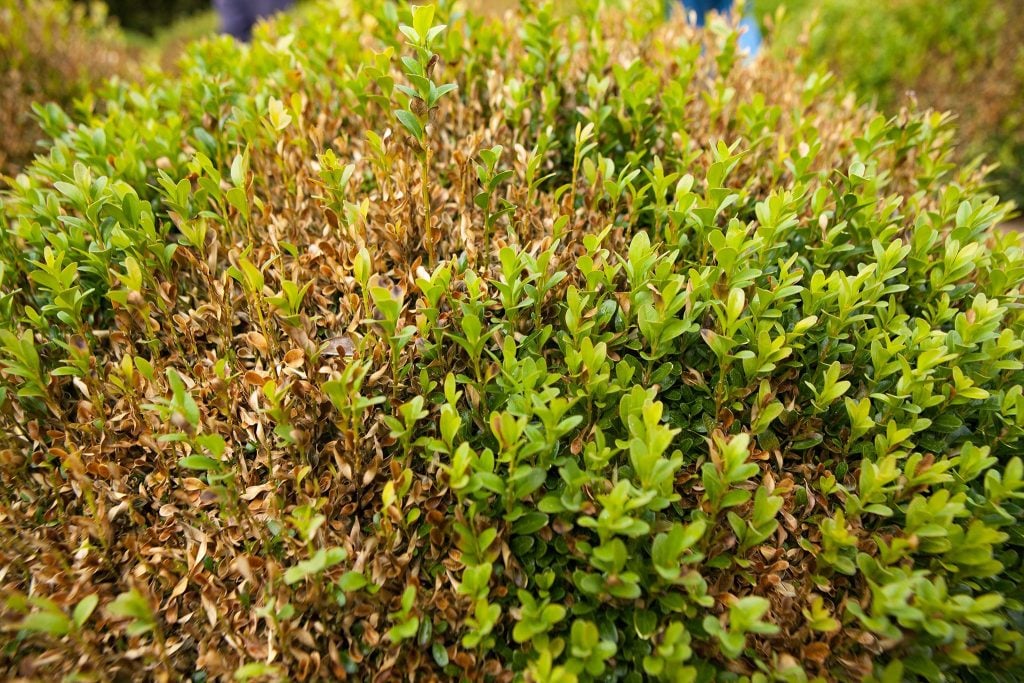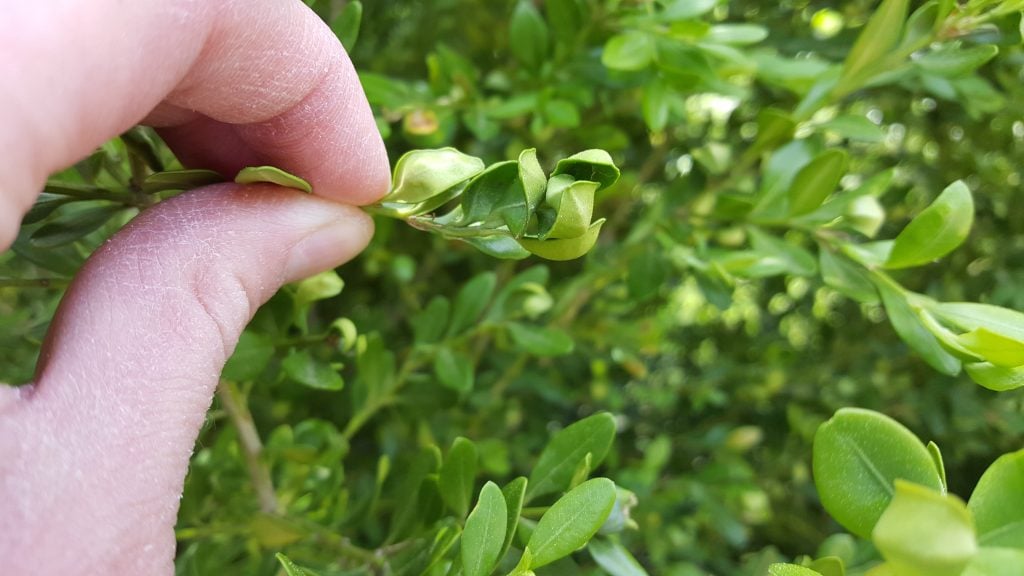Table of Contents
Box blight is a plant disease caused by fungi that attack mainly the leaves and stems of the plant. Any garden box is prone to contract box blight during the autumn and spring season.
The fungi responsible for box blight are Calonectria Pseudonaviculata and Calonectria Henricotiae. They can cause extreme damage to the plants, especially to the younger ones, and require high humidity to spread.
First discovered in 1998 in Britain, box blight has the potential to weaken the plant, although it can’t completely kill the plant since it doesn’t attack the roots.
What Does Box Blight Look Like?
Since box blight is a threat to plants, it is important to find the symptoms of box blight at the earliest. When someone learns about bright box disease immediately, the question arises in their minds, “What does a bright box look like, or how do we identify box blight?”
The identification of box blight isn’t a complicated process. Generally, we can figure out if our plant is infected by box blight by seeing the below-mentioned symptoms. However, box tree caterpillar and box blight have similar symptoms, so be a little careful while identifying the exact cause of the disease.
You can even consult an expert if you are unable to figure out the disease yourself.
1. Brown or Yellow Leaves
These are the early warning signs that indicate that your plant might be infected by box blight. After some time, these leaves fall off, leaving bare patches in the area where they were.
2. White Spores
If you see any white spores underside the leaves, then there might be a possibility that the plant is infected with box blight.
3. Black Streaks and Diebacks
In a few cases, black streaks and diebacks are also seen on young stems, which are indications of box blight.
Box Blight Treatment

Early diagnosis of box blight will prevent the disease from spreading and will help to find the best treatment for the plant. Our responsibilities don’t end with merely spotting box blight. They also include taking the necessary measures to stop the box blight from harming our precious plants.
Hence it is equally important to know the exact treatment methods for box blight, as wrong treatments will not benefit the plant but harm it only.
Following are the treatment methods that can be adopted to treat box blight:
1. Cut the Part of The Plant that is Infected with Box Blight
It is a crucial step that ensures that box blight won’t be able to spread if we cut the area infected by it in the early stages only.
You can even trim a few inches around the infected area to be on the safe side. If the infection is more, you can cut a larger portion of the garden box.
It is important to dispose of these cuttings and wastes far away from the garden after they have been discarded. Do not add these cuttings to your compost, as it will interfere with the growth of healthy plants.
2. Sterilizing the Equipment
Use sterilized equipment to cut the infected part. After cutting the infected part, sterilize the equipment again. This will eliminate the possibility of the plant getting infected with box blight in the future due to the fault in the equipment.
Also, use sharp scissors or trimmers to remove the affected areas. The use of blunt equipment may increase the risk of spreading the infection.
3. Try to Keep the Surroundings Moisture-Free
Moisture is the biggest friend of box blight. To protect plants from box blight, it is important to keep the surroundings free from moisture. This can be done by avoiding overwatering the boxes and also by growing these boxes in areas where there is adequate sunlight.
Grow the box in dry soil. If possible, change the topsoil of the surroundings if the area was infected by the box blights. While watering the plant, avoid overhead watering. It will ensure that the foilage is not getting wet, thus, preventing box blight.
4. Use Fungicides
Fungicides kill fungi, and as box blight is a fungal disease therefore, fungicides are helpful in inhibiting the growth of box blight and thus protecting the plant.
There are many fungicides available in the market which hinder the growth of box blight, thus keeping the plants safe from any damage.
However, one thing that should be kept in mind is that fungicide can aid in the protection of plants, but alone they are not able to protect plants from box blight.
Fungicides should be sprayed mostly in the rainy season as during this period of the year, a plant is most prone to being infected with box blight, and they would help in slowing down the spread of infection.
5. Feeding the Plants
Feed the plants with fertilizers to minimize the growth of box blight. Do not use nitrogen-rich fertilizers as they promote the growth of new parts, making the plant denser and thus promoting box blight.
Feeding should be done at the plant base and in the spring or autumn season. Avoid overfeeding the garden box. This can be harmful to them.
6. Mulching
Mulching is the process of covering the soil with organic material such as the bark of trees, pine leaves, etc. It keeps the soil healthy and retains moisture, ensuring that the plant doesn’t die due to dryness.
Mulching helps to reduce fungal infections and therefore is quite efficient in protecting the plant from box blight. It will also reduce the chances of fungal spores infecting the leaves by splashing from the ground.
7. Complete Removal of Box Hedge
This is the only solution left when feeding, pruning, mulching, etc., everything fails.
Even after taking all measures, you find no improvement in the condition of the box hedge. The best option, then, would be to remove the hedge entirely. Waiting for new shoots to sprout is a waste of time, as they will also be infected with the same disease. There is no possibility that it would be safe from box blight disease.
How to Prevent Box Blight

As we know, prevention is better than cure. Therefore, we should take a few steps in advance to prevent the spread of box blight to protect our plants.
These Steps Include:
- Do not plant the boxes too densely. Boxes require air to prevent the propagation of box blight. If these plants are grown too close to each other, air won’t be able to penetrate, and hence box blight will be able to spread,
- Trim the plants regularly, especially during the growing season. Trimming is beneficial for the plants as it helps in removing dead and infected parts of the plant that can hinder the growth of the plants.
- Try to grow the box plant away from other plants. As we know, box leaves are prone to be infected with box blight, so try to keep the box away from other plants for the safety of the other plants.
- If you observe that the box is damaged severely by the box blight, then don’t hesitate to uproot the entire box. You can plant a new box in that place after some time and after disinfecting the area properly.
- Clean your garden timely. A clean garden is the key to healthy plants and will ensure that the plants are saved from box blight in the future. Remove any dead plants or leaves surrounding the healthier ones.
- Keep a regular check on your plants. It will help to locate the infection in the early stages, and we can follow the treatment at the earliest and prevent the infection from spreading further.
- Before planting a new box in your garden, keep it isolated for some time. Once you are sure that it is not infected with any kinds of diseases, then only introduce it in your garden.
- Sanitize the tool with a suitable disinfectant before using them every time. It will eliminate the possibility of the spread of infection from the infected plant to the healthier ones.
Alternatives for Box Hedge

If, even after taking the necessary preventive measures, you find that the box hedge is not able to grow, you can consider the following alternatives that are no less beautiful than the box hedge and will never fail to increase the charisma of the garden.
1. Japanese holly
They have glossy leaves and have a similar appearance to that of the box hedge. They are shear tolerant; hence, they are good to be used as hedges. They can survive even in shady regions.
2. Mock privet
It is a member of an olive family which looks pretty when planted in the gardens. During the flowering season, they impart a very pleasant fragrance in the atmosphere. They do not grow in the cold regions.
3. Osmanthus
These evergreen shrubs also have glossy leaves. During their flowering season, they make the environment pleasant with the smell. Osmanthus has got many health benefits too.
4. Lavender
They do not require any heavy care and maintenance and offer a lot of colour variations. Lavender also helps in the prevention of soil erosion. They also act as a windbreak.
Conclusion
Box blight is a dangerous fungal disease that is quite lethal and affects a plant’s growth. If not controlled, it can kill the plant. Don’t take things lightly.
If you find any unusual symptoms, then try to find out the exact reason underlying the safety of your plants.
It is important to identify and take the necessary steps and precautions to save our plants from diseases and ensure that the plants remain healthy and long-lived.





